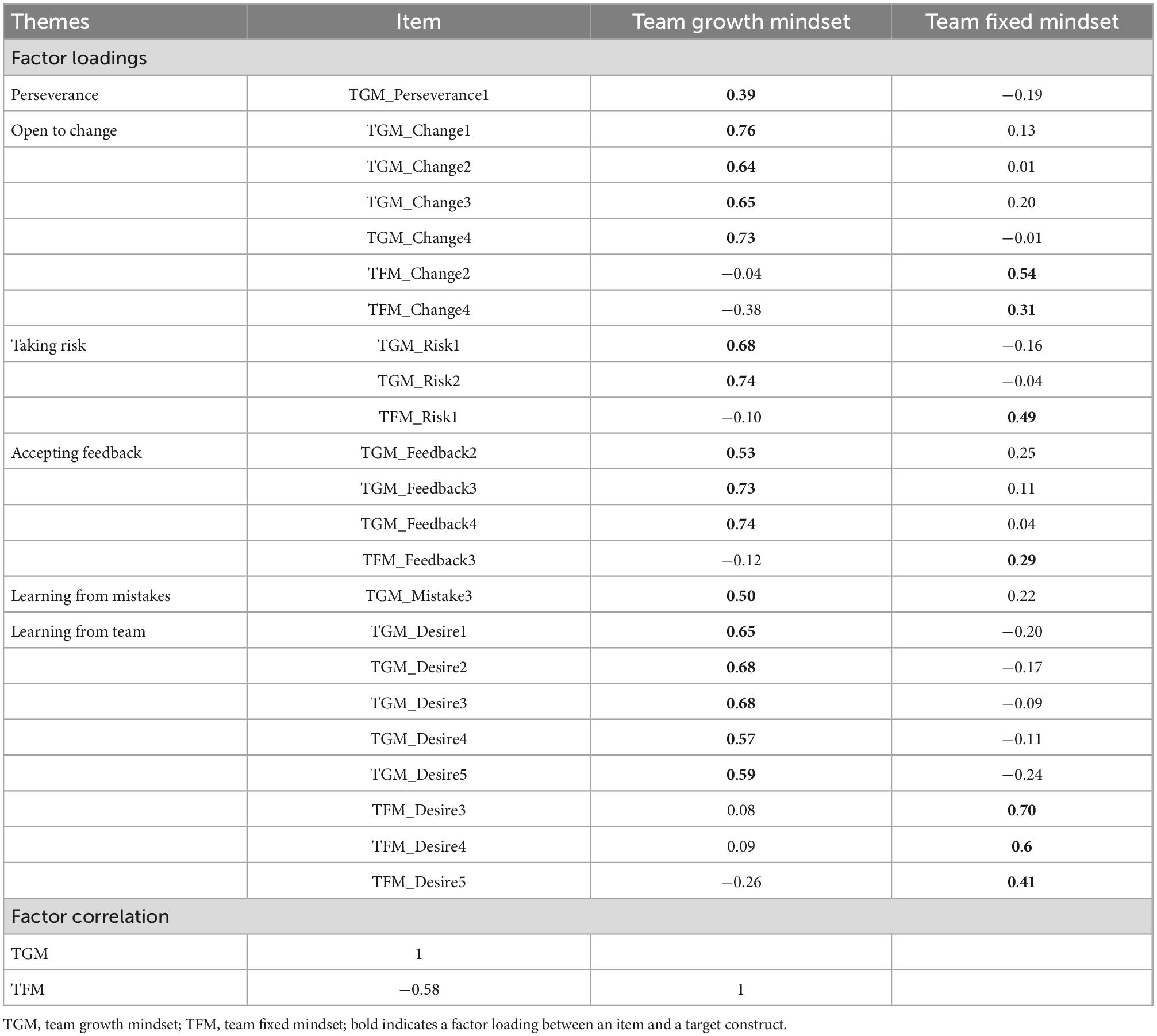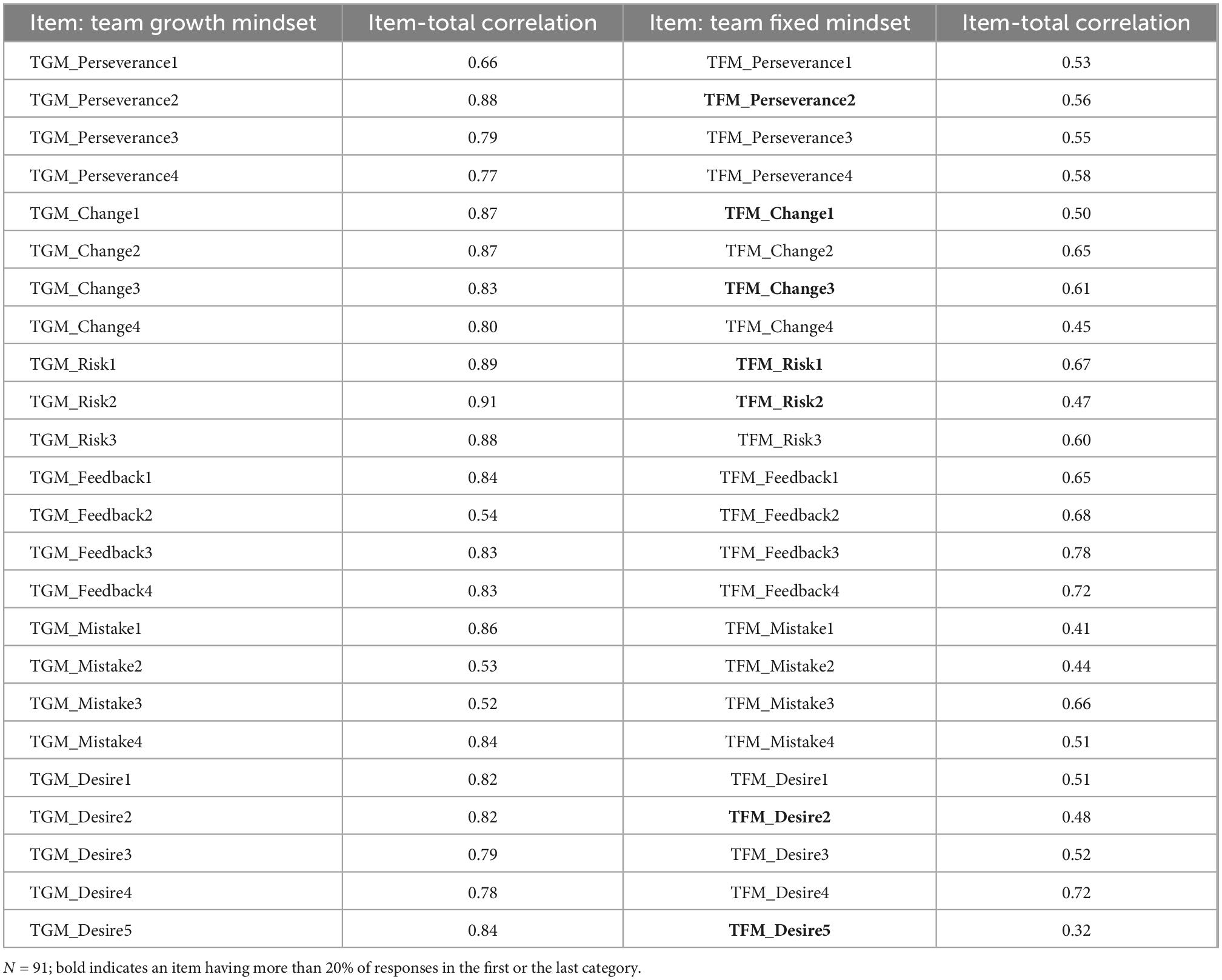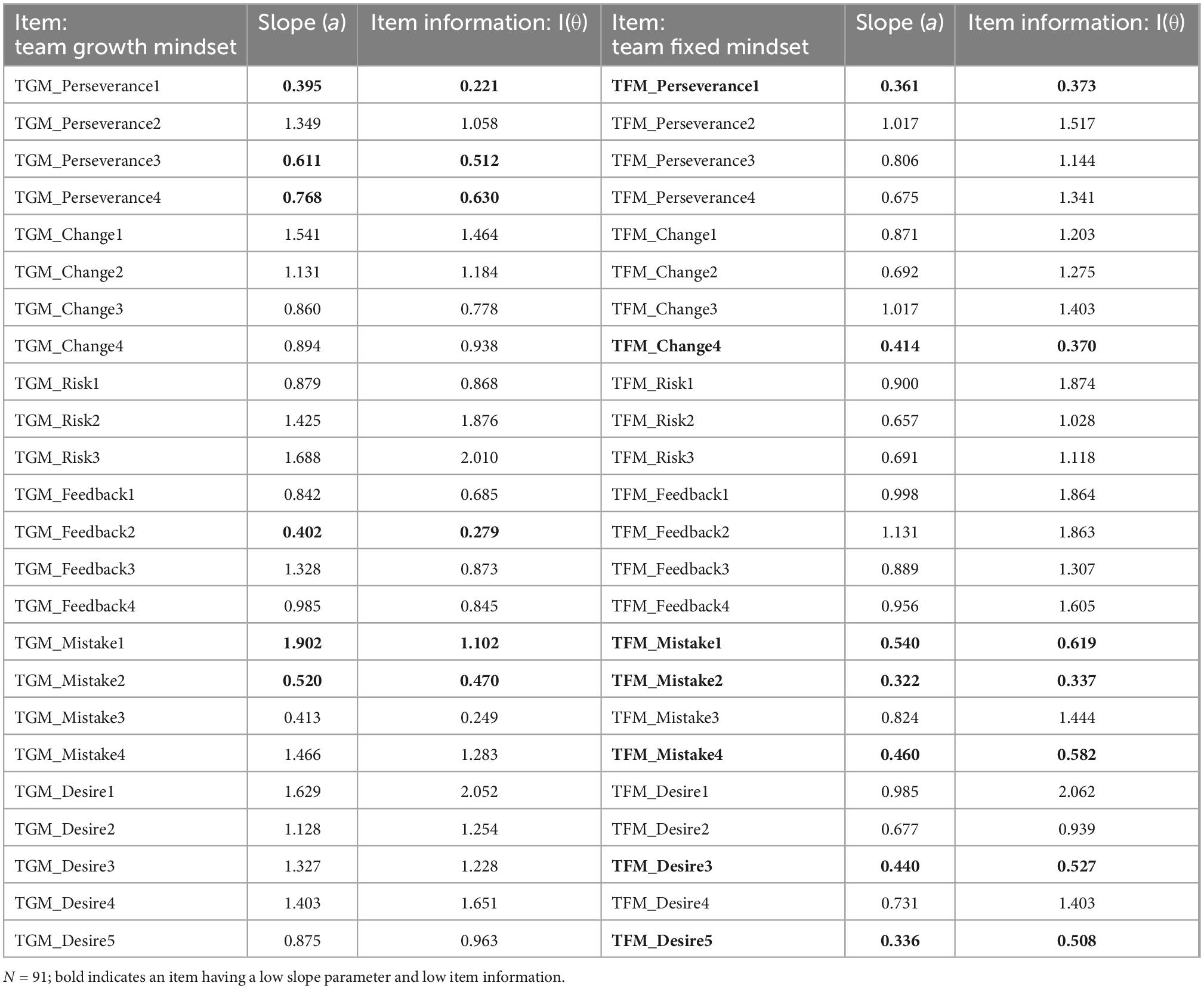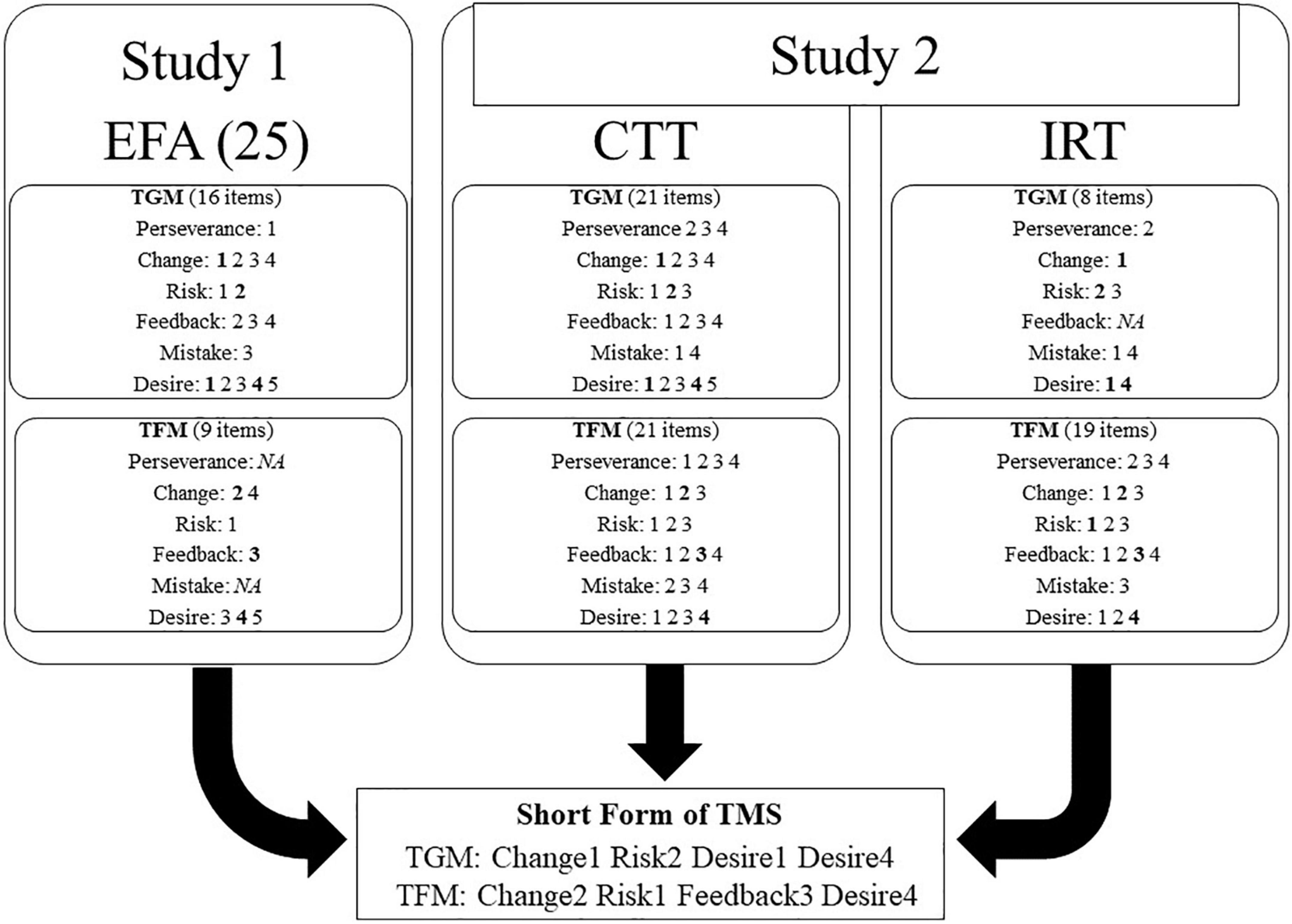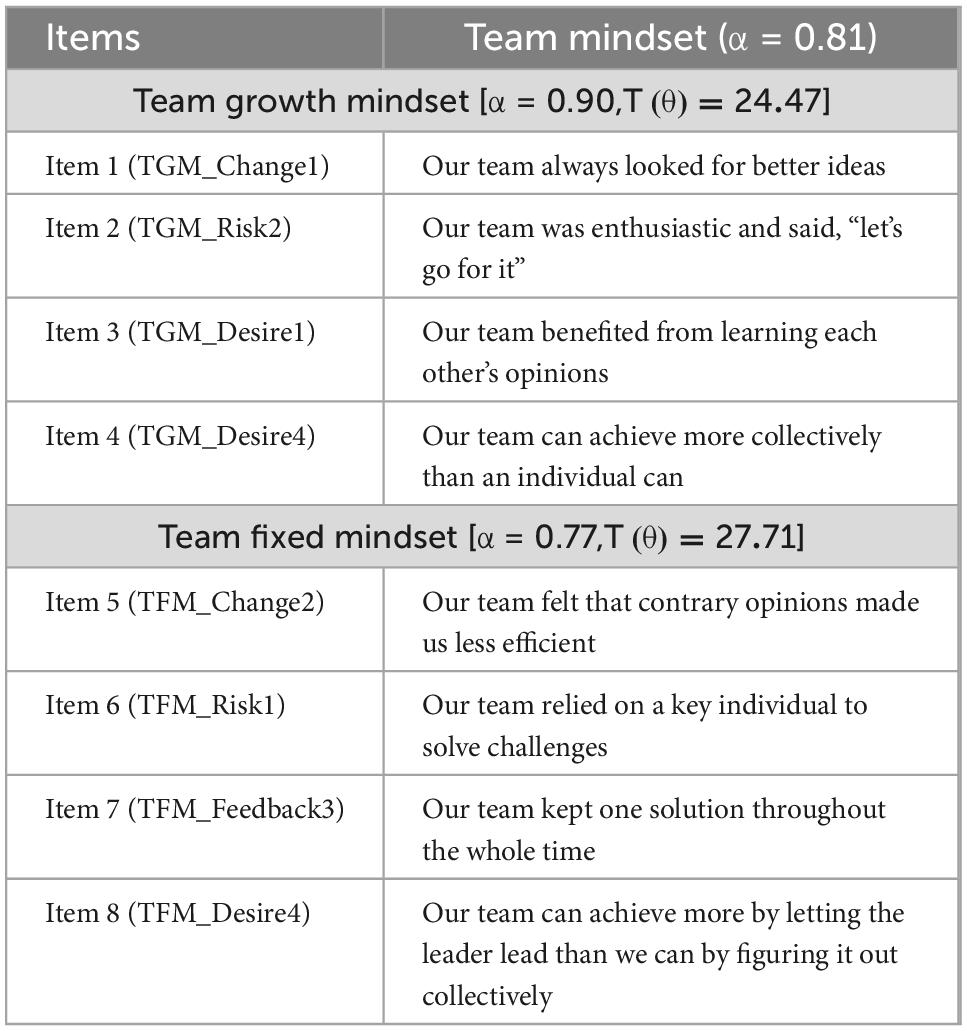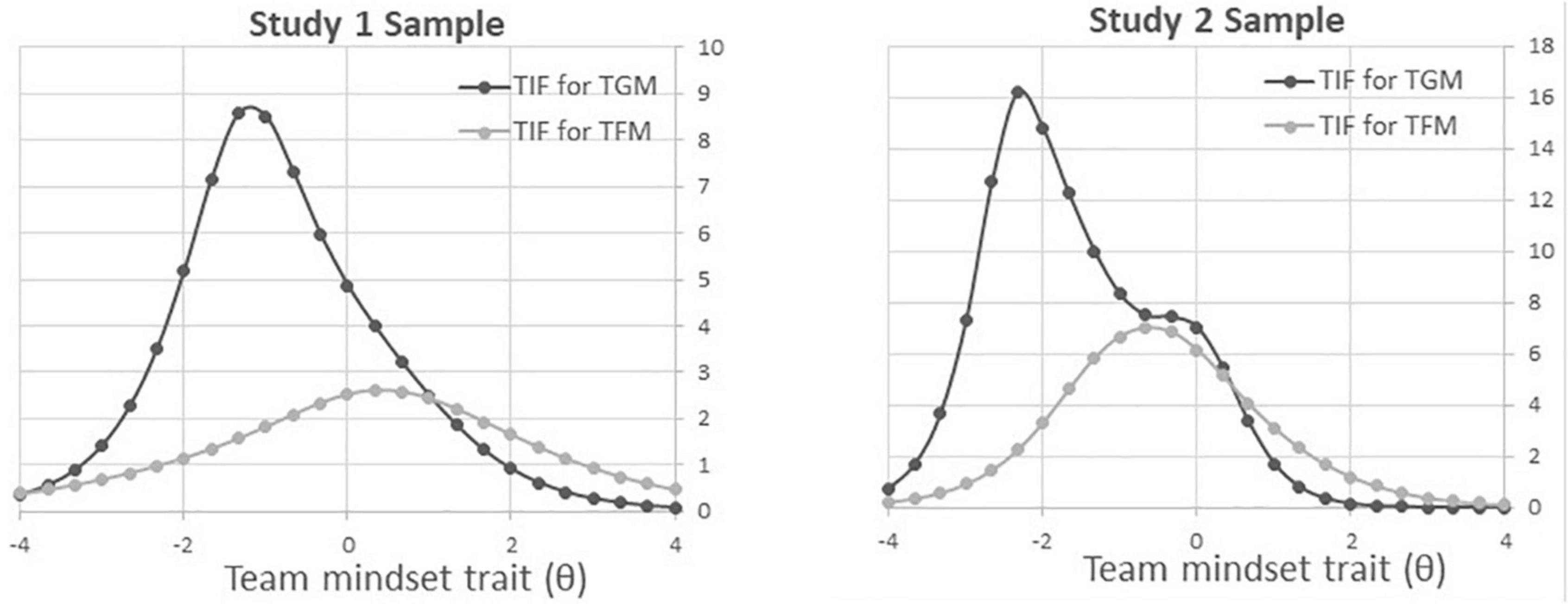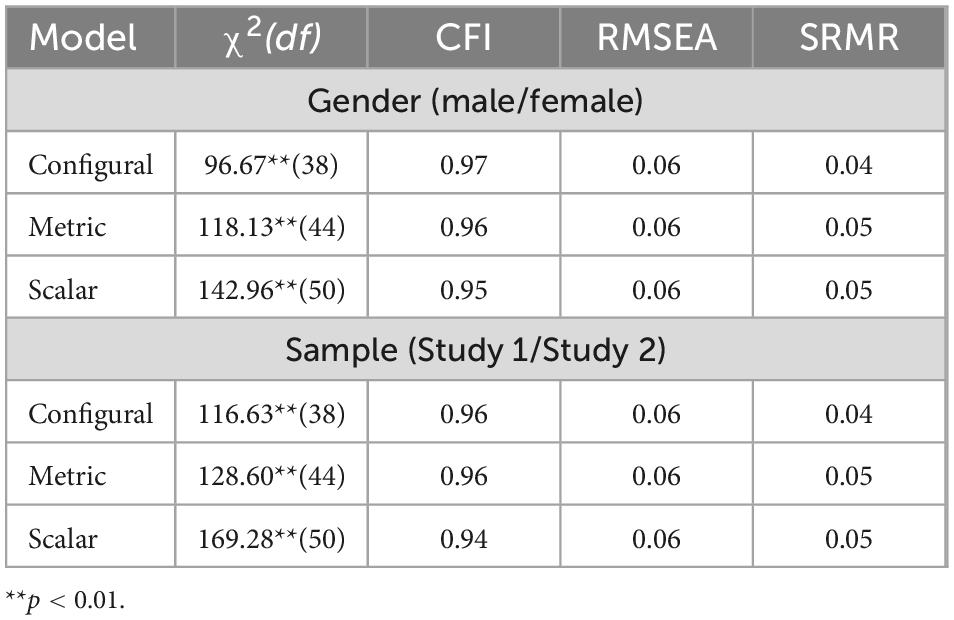- 1BK21 Four R&E Center for Psychology, Korea University, Seoul, Republic of Korea
- 2Graduate School of Education, Yonsei University, Seoul, Republic of Korea
- 3Department of Education, Korea University, Seoul, Republic of Korea
As the importance of a team function in educational and industrial settings has been emphasized, practical knowledge of team mindsets can be useful. Previous studies extended the mindset concept of individuals to the team context and developed a 48-item team mindset scale (TMS). However, the original TMS had an issue regarding the length of the survey when using it with many other scales. Therefore, the present study tested the psychometric properties of 48 items under a variety of perspectives to suggest a shorter version of TMS measuring the perception of the team mindset and having the desirable characteristics. We examined the construct validity of the TMS with exploratory factor analysis (EFA) with target rotation in Study 1 and tested item-level psychometric properties of the TMS in Study 2 based on classical test theory (CTT) and item response theory (IRT). Based on the result, we suggested the short-form of TMS, an 8-item TMS with adequate psychometric characteristics.
1. Introduction
Drawing upon Carol Dweck’s theoretical framework of growth and fixed mindsets, most studies have explored if one’s mindset can impact other possible outcomes, such as academic results or performance of individuals (Ravenscroft et al., 2012; Pennington and Heim, 2016). Dweck (2006) uses the terms growth and fixed mindset to refer to the implicit beliefs people possess about the malleability of intelligence (Heslin and VandeWalle, 2008; Ravenscroft et al., 2012; Özduran and Tanova, 2017). According to Dweck (2012), fixed mindset individuals believe that human attributes are simply fixed traits; they accept their abilities as unchanging. Fixed mindset students are outcome-focused and screen out negative feedback. In comparison, growth mindset individuals believe that anyone can become substantially more intelligent through their effort and education, or that all people can change and develop their behavior, personality, or character over time (Dweck, 2012). Growth mindset students are process-focused, seeking and responding to feedback (Dweck, 2006).
Scholars have found that individual growth mindsets can increase academic performance (Ravenscroft et al., 2012; De Castella and Byrne, 2015; Pennington and Heim, 2016), help out to seek difficult challenges (Lee et al., 2012), enhance motivation for academic goals (Aditomo, 2015; Gheith and Aljaberi, 2017), promote feedback activities (Lee et al., 2012; Forsythe and Johnson, 2017), and support better relationships and willpower (Dweck, 2012). Thereby, many mindset studies have found the way to foster the growth mindset. Most of the studies have focused on the individual mindset; however, as the importance of teams in both workplaces and education settings has been emphasized, it would be practical and applicable knowledge to discuss team mindsets. Nevertheless, only few studies have contemplated team mindsets. The mindset studies about teams and the related characteristics remained under-studied (Han and Stieha, 2020; Han et al., 2022) even if a few studies have suggested possible connections between individual mindsets and team mindsets (e.g., Heslin et al., 2005; Gutshall, 2013; Özduran and Tanova, 2017).
Several theories propose the possibility of team mindsets. Relational theory values the idea that collectives are to be differentiated from an aggregated of individuals where they are ongoing relationships with team members rather than in the individual mind (Drath et al., 2008). In addition, the leader-member exchange theory supports team mindsets as it values the two-way relationship between members in a team, as each team member’s mindsets or behaviors can influence mutual trust and willingness to share their knowledge (Han et al., 2022). Although we found no studies that directly discuss the concept of team mindset, several studies show indicators of individuals’ mindsets impacting mindsets on the team. For example, Gutshall (2013) illustrates the importance of team members’ trust in others. Other studies suggest the importance of collective or group mindsets by examining the effects of managers’ mindsets (Heslin and VandeWalle, 2008; Özduran and Tanova, 2017). Heslin et al. (2005) found that managers with a growth mindset tend to conduct active coaching activities for their team members, leading to their organizational citizenship behaviors. These studies suggest a relationship between individual and collective/team mindsets through findings that leaders can influence others’ thoughts and outcomes. More studies are needed to examine the possibility of team mindsets representing teams rather than individuals.
As a recent team mindsets study, Han et al. (2019) have explored common themes regarding team growth and fixed mindset based on a qualitative study by conducting interviews and literature review. Based on their findings, team mindset scale (TMS) has been developed to grasp the team mindset themes via a quantitative method (Han and Kim, 2020). The concept of a team mindset has also been explored to examine if individual mindsets increase a team growth mindset and shared leadership (Han et al., 2022), which explored the possibility of the TMS being different from individual mindsets. The TMS is a questionnaire having 48 items measuring the team growth mindset and team fixed mindset; however, there is a limitation to using the original length of the test. Statistically, reliability and validity tend to be higher when a scale length is longer with more items (Ebel, 1967; McDonald, 1999; Lord and Novick, 2008). In practice, however, the longer survey is likely to derive fatigue, tiresomeness, or less motivation followed by low response rates. Therefore, it is significantly related to the low quality of the measurement (Hart et al., 2005; Andreadis and Kartsounidou, 2020) because multiple scales are usually combined in a single survey to measure different aspects of individuals simultaneously.
Based on this concern, the current study aims to develop a short version of TMS. Psychometric properties of the original team mindsets questionnaire were examined in a variety of aspects to reach the desired length of the scale. The other mindset scales, such as individual-level mindsets (Dweck, 1999) and creative mindsets (Karwowski, 2014), have a relatively shorter number of items as 8 and 10, respectively. Therefore, we proposed a similar length of a short-form of TMS through Study 1 and Study 2.
2. Study 1
In Study 1, the measurement properties of the 48-item were examined via exploratory factor analysis (EFA) with target rotation. The construct validity was investigated regarding the six themes (Han et al., 2019) and team mindset constructs.
2.1. Materials and methods
2.1.1. Participants and data collection
Participants were recruited from a public research university in Spring 2019. We specifically stated that the target participants would be those who experienced team projects within 6 months because the TMS measured their perception of team’s mindsets. A total of 1,297 students responded to the original TMS, and Study 1 used 908 responses after dropping the incomplete surveys [Female: 62.2%, Caucasian: 79.7%, Age: 27.6mean, 10.47std, (18, 70)range].
2.1.2. Measures team growth and fixed mindset questionnaire
Each team growth and fixed mindset was a 5-point Likert scale (1 = Strongly Disagree to 5 = Strongly Agree) of 24-item and asked about six sub-themes of the team mindset: (a) perseverance; (b) openness to change; (c) taking risk; (d) accepting feedback; (e) learning from mistakes; (f) learning from team. Four items measured each theme except for two themes: task risk (three items) and learning from the team (five items).
2.1.3. Analysis
We supposed a certain number of factors to be estimated based on Han et al.’s (2019) findings about the six main themes under the two team mindsets. However, the factor structures were still tentative because the recent team mindset studies still need to be validated in a variety of settings. Therefore, we tested a 6-factor structure through the EFA with target rotation (Browne, 1972a,b) to reflect the hypothesized factor structure and explore the possible item-factor relationships. The EFA with target rotation fits the model with a certain number of factors as CFA and allows the cross-loadings as the general EFA (Browne, 1972b; Zhang et al., 2019). We identified the items representing the six themes first; the items not measuring their target theme were considered inadequate and screened out from further analysis. Additional factor analysis was conducted to examine item-team mindset relationships. All analyses were based on the maximum likelihood (ML) estimator through Mplus 8.4 (Muthén and Muthén, 1998–2017).
2.2. Results
2.2.1. Exploratory factor analysis with target rotation
A 6-factor model representing six themes was tested first; factor loadings between items and the relevant theme were expected to be bigger than the other factor loadings between items and irrelevant themes. For example, eight items were to measure Perseverance-theme (four-item for each team growth and fixed mindset); the factor model of the Perseverance-theme was expected to be constructed with the eight items rather than with the other 40 items. The model fit of the 6-factor model was appropriate (comparative fit index (CFI) = 0.94, root mean square error of approximation (RMSEA) = 0.04, standardized root mean square residual (SRMR) = 0.03) compared to criteria (CFI > 0.95, RMSEA < 0.06, or SRMR < 0.05; Hu and Bentler, 1999). Therefore, we examined item properties given the factor analysis model and concluded some of the items as inappropriate; when their factor loadings were not statistically significant, or the targeted factor loadings were close to 0 which were expected to be greater than zero, or the item had the equal signs of factor loadings on both team growth and fixed mindsets indicating the same side of the continuum. In addition to such criteria, we re-evaluated item contents; therefore, 22 out of 48 total items were ruled out from further factor analysis.
With the remaining items, the 2-factor model representing the team growth and fixed mindsets was tested. The model fit was not good enough, and we found the source of a misfit from three team fixed mindset items: TFM_Risk3, TFM_Change3, and TFM_Feedback2. Their factor loadings were against the other team fixed mindset items, but in line with team growth mindset items. These items were excluded from the revised factor model for the team mindsets, and modification indices were considered for a better model fit. The modification indices suggested some unique factor variance correlations. We found that the two sets of items had a similar word but indicated different team mindsets; therefore, their unique factor correlations were estimated: TGM_Change4 with TFM_Change4; TGM_Feedback3 with TFM_Feedback3. The modified 2-factor model had an adequate global fit (CFI = 0.94, RMSEA = 0.06, SRMR = 0.03).
To sum up, Study 1 investigated construct validity regarding team mindsets and tested the item-construct associations. Based on the result, the 23 items in Table 1 showed appropriate psychometric properties: their factor loadings were higher than or close to 0.3 and the corresponding item contents represented individual’s perception of team’s mindsets.
3. Study 2
While Study 1 evaluated the construct validity of the team mindset items by using dimensional properties, Study 2 investigated item-level properties. The item-level analyses were conducted with two theoretical approaches: classical test theory (CTT) and item response theory (IRT). Later, results from Study 1 and Study 2 were considered together to set a short-form TMS.
3.1. Materials and methods
3.1.1. Participants, data collection, and measures
Study 2 used empirical data from the workplace although the team mindset measures were identical to Study 1. The recruited participants were 400 team members within a department of public works that resided in a traffic division in the continental USA. Unfortunately, the participation rates were extremely low due to the unprecedented pandemic; therefore, Study 2 used 91 responses from the employees without missing on the team mindset measures [Male: 62%, White: 47.8%, Age: 40.9mean, 12.85std, (21, 80)range].
3.1.2. Analysis
A complex model estimating many parameters is less likely to converge with a small sample size. A factor analysis needed to concern multiple team mindsets; however, the second sample was relatively small to test all relationships among 48 items and the two team mindsets due to the convergence issue (MacCallum et al., 1999). Therefore, we assumed unidimensionality of each team mindset and conducted item analyses. Each set of items within the team growth mindset and the team fixed mindset was separately analyzed. Under the CTT framework, item-total correlations for the item discrimination level, category response rates for checking flooring and ceiling effects, and reliabilities were evaluated. For the IRT analysis, we estimated item parameters and item information given a generalized partial credit model (GPCM; Muraki, 1992) using PARSCALE (Muraki and Bock, 1993) with an expected a posterior (EAP) estimator.
3.2. Results
3.2.1. Classical test theory approach
Table 2 presents item properties for team growth and fixed mindsets. First, a Pearson correlation coefficient between the item and the total score was evaluated as the item discrimination index under the CTT framework. All items showed moderate or higher discrimination power based on the criteria (i.e., ρ 0.40; Ebel, 1965), except for an item in the team fixed mindset (TFM_Desire5). Second, the flooring and ceiling effects were examined by checking response rates in the first category (Strongly Disagree) and the last category (Strongly Agree). If most people responded to the first or the last category, such items might have detected the extreme level of team mindset only. 19 team growth mindset items and six team fixed mindset items showed an over 20% response rate in the last category. Lastly, we examined Cronbach’s alpha (α) coefficient and considered it acceptable when α was greater than or equal to 0.70 (Cortina, 1993). Both team growth mindset (α = 0.97) and team fixed mindset items (α = 0.91) showed appropriate test reliability.
3.2.2. Item response theory approach
The items having low item discrimination and information were not preferred for the final set of TMS to keep the high level of precision of the test (Baker, 1985). Table 3 presents parameter estimates by fitting GPCM to team mindset items: item slope (i.e., item discrimination; a) and the item information.
With the moderate cut-off for the item slope parameter (0.65 ≤ a < 1.34; Baker, 1985), we identified the items to be dropped from the short-form TMS. In general, team growth mindset items had high slope parameter values (); therefore, we applied the upper limit of the moderate item slope (1.34) to them to select the small number of items for the short-form TMS. On the other hand, the average slope parameter of team fixed mindset items was moderate (), that is, the lower limit (0.65) of the cut-off value was used. The 16 items of the team growth mindset and seven team fixed mindset items had the slope parameters below the designated cut-off value, and they were not preferred for the short-form TMS.
The item slope and the item information were tightly related: an item with a low item slope will give less information on the target construct. Therefore, we also considered the item information of each item and preferred the item having the higher item information. The third and the last column of Table 3 present the item information of each item at the middle level of trait θ (team mindset θ = 0). The six team growth mindset items (TGM_Perseverance1,3 4, TGM_Feedback2, TGM_Mistake1,2) and the seven team fixed mindset items (TFM_Perseveranc1, TFM_Change4, TFM_Mistake1,2,4, TFM_Desire3,5) had relatively small information at the middle level of team mindset.
3.2.3. Item selection for short-form of TMS
For the final set of items of short-form TMS, we took the two study results together and ruled out the items with less desirable psychometric properties across the two studies. Figure 1 represents the ruling-out strategy and the selected items. Study 1 tested the construct validity based on the dimensional aspects of the items, and Study 2 conducted the item-level analyses. The eight items were selected as they performed appropriately in common across the two studies. The selected items represented the team mindsets well based on Study 1 and had moderate or high discrimination power contributing to the high information on the scale based on Study 2.
Table 4 lists the eight items of the TMS short-form and the related test properties. Each team growth mindset and team fixed mindset scale had α of 0.90 and 0.77, respectively, and their test information [T (θ)] were 24.47 and 27.71 at the middle level of the team mindset (team mindset = 0), as we extended the item information function to the test-level. The team fixed mindset had a bit higher test information than the team growth mindset and as the test information curves in Figure 2. Such test information patterns of team mindsets were similar for Study 1 and Study 2.
3.2.4. Factorial invariance on short-form of TMS
The current study had the datasets representing the different numbers of male and female participants, and the participants for Study 1 and Study 2 were from educational settings and workplaces, respectively. However, the measurement needed to be consistent across different gender groups or settings. In other words, regardless of gender and the group from the different settings, individuals with an identical level of latent team mindsets should have an identical conditional probability for the observed team mindset score given the latent level. To verify the equivalent measurement across gender and samples for Study 1 and Study 2, we set the 2-factor model representing team growth mindset and team fixed mindset and tested factorial invariance across sub-groups (Vandenberg and Lance, 2000; Millsap, 2012). The ML estimator was used throughout Mplus 8.4 (Muthén and Muthén, 1998–2017) for the analyses.
For the gender group, two datasets of Study 1 and Study 2 were combined, and the factorial invariance between males (N = 390) and females (N = 575) was examined. From a configural invariance model to a scalar invariance model, more parameters were identically constrained between groups. Table 5 presents the model fit of testing factorial invariance. Based on the alternative fit indices (i.e., CFI, RMSEA, and SRMR), we concluded that the general model fit was enough to hold scalar invariance (CFI = 0.95, RMSEA = 0.06, SRMR = 0.05). In other words, there was no measurement bias on the short-form of TMS regarding different gender groups. In addition, the same analysis was conducted across two samples from Study 1 (N = 908) and Study 2 (N = 91). As more parameters were equally constrained, the global fit was slightly worsened; however, all alternative fit indices were acceptable at the scalar invariance level (CFI = 0.94, RMSEA = 0.06, SRMR = 0.05). Therefore, factorial invariance hold across samples from different settings as well as gender.
4. Discussion
Due to the practical issue regarding the test length of 48-item TMS (Han and Kim, 2020), the current study aimed to develop a short-form of TMS that could as performed and had adequate psychometric properties as the long-form. We investigated the items from various perspectives to select the desired length of TMS. Study 1 tested the dimensionality of the TMS with EFA based on the target rotation. Items were preferred for the short-form of TMS when they showed strong relationships with the target team mindset and justified the hypothesized relationship. For example, the factor loadings were expected to be positive and negative on the team growth mindset and the team fixed mindset respectively. Study 2 examined item-level properties. Items were considered appropriate when they had less floor and ceiling effects but had representative item discrimination and information on the team mindsets. For the final set of TMS items, items repeatedly showed suitable psychometric properties in both studies were selected; the 8-item TMS, four items for each team mindset, was set for the short-form of TMS.
The TMS was examined with the students’ data in Study 1 and the workplace data in Study 2. The student data had a large sample size, so parameter estimates were relatively stable (Embretson and Reise, 2000). However, the information about the team characteristics, such as team membership, types of team projects, or tasks were limited. Hence, we conducted Study 2 using a workplace dataset with the team information. Only a small number of participants completed the survey because of the COVID-19 pandemic. Therefore, we used the robust estimator in Study 2 and separately conducted the item-level analyses given the unidimensionality assumption of team mindsets to lessen the possible estimation issues due to the small sample size. To complement each of the studies, we selected the final set of items when they showed appropriate performances across the two studies.
We found the ceiling effect of the team growth mindset as many participants responded to the strongly agree category. It indicated that people quickly answered the corresponding items regarding the team growth mindset (Allen and Yen, 2001). Although they had a low level of perception of the team growth mindset, they could easily identify the team’s growth mindset with the TMS (Zanon et al., 2016). We tried to lessen the ceiling effect by excluding items with high response rates in the last category. However, the short-form TMS still had the highest test information on the left side of the test information function distribution, as presented in Figure 2. On the other hand, the team fixed mindset items had the highest value in the middle of the test information function distribution. Follow-up studies need to replicate validations on the short-form of TMS with different samples and compare the results to the current study.
Although the present study was at the early stage of measuring the perception of the team’s mindsets, it makes meaningful contributions to the team study. First, it extends mindset research to the context of teams and their mindsets. Second, it offers a practical team mindset instrument for teams in education. The short-form of TMS has a shorter length but has appropriate psychometric properties. Therefore, the current TMS would be useful to measure the team growth and fixed mindsets without the issue derived from a lengthy instrument.
Some limitations need to be further studied. First, the test information curve for the team growth mindset had bimodal information distribution. The possible reason is the combination of the small sample size and participants’ tendency toward ‘agree’ categories [sum of category (4) somewhat agree and category (5) strongly agree]. We expect a cross-validation study with a larger sample would verify this aspect later. Second, the test information of the team fixed mindset was smaller than the team growth mindset’s, that is the test information curve of team fixed mindset occupied a smaller area as shown in Figure 2. It is known that the item slope is positively related to item information, and a sum of the item information indicates the test information (Baker, 1985; Embretson and Reise, 2000). Therefore, the lower item slopes might be related to not only the smaller item information, but also the smaller test information. The item slope represents the item discrimination power; hence, revising the item sets might be needed to improve the discrimination power of the items across team fixed mindset levels. Lastly, the current study has not examined relationships between the short-form of TMS and other external variables. We encourage future studies to explore various relationships with other constructs and demographic characteristics to examine how perception of team’s mindsets is related to the other constructs within individuals or teams.
Data availability statement
The raw data supporting the conclusions of this article will be made available by the authors, without undue reservation.
Ethics statement
The studies involving human participants were reviewed and approved by the Boise State University. The patients/participants provided their written informed consent to participate in this study.
Author contributions
All authors listed have made a substantial, direct, and intellectual contribution to the work, and approved it for publication.
Funding
BK21 Four R&E Center for Psychology and Yonsei University (2021-22-0027) supported this research.
Conflict of interest
The authors declare that the research was conducted in the absence of any commercial or financial relationships that could be construed as a potential conflict of interest.
Publisher’s note
All claims expressed in this article are solely those of the authors and do not necessarily represent those of their affiliated organizations, or those of the publisher, the editors and the reviewers. Any product that may be evaluated in this article, or claim that may be made by its manufacturer, is not guaranteed or endorsed by the publisher.
References
Aditomo, A. (2015). Students’ response to academic setback: ‘Growth mindset’ as a buffer against demotivation. Int. J. Educ. Psychol. 4, 198–222. doi: 10.17583/ijep.2015.1482
Allen, M. J., and Yen, W. M. (2001). Introduction to measurement theory. Long Grove, IL: Waveland Press.
Andreadis, I., and Kartsounidou, E. (2020). The impact of splitting a long online questionnaire on data quality. Surv. Res. Methods 14, 31–42. doi: 10.18148/srm/2020.v14i1.7294
Browne, M. W. (1972a). Oblique rotation to a partially specified target. Br. J. Math. Stat. Psychol. 25, 207–212. doi: 10.1111/j.2044-8317.1972.tb00492.x
Browne, M. W. (1972b). Orthogonal rotation to a partially specified target. Br. J. Math. Stat. Psychol. 25, 115–120. doi: 10.1111/j.2044-8317.1972.tb00482.x
Cortina, J. M. (1993). What is coefficient alpha? An examination of theory and applications. J. Appl. Psychol. 78, 98–104. doi: 10.1037/0021-9010.78.1.98
De Castella, K., and Byrne, D. (2015). My intelligence may be more malleable than yours: the revised implicit theories of intelligence (self-theory) scale is a better predictor of achievement, motivation, and student disengagement. Eur. J. Psychol. Educ. 30, 245–267. doi: 10.1007/s10212-015-0244-y
Drath, W. H., McCauley, C. D., Palus, C. J., Van Velsor, E., O’Connor, P. M., and McGuire, J. B. (2008). Direction, alignment, commitment: toward a more integrative ontology of leadership. Leadersh. Q. 19, 635–653. doi: 10.1016/j.leaqua.2008.09.003
Dweck, C. S. (1999). Self-Theories?: Their Role in Motivation, Personality, and Development. London: Psychology Press.
Dweck, C. S. (2012). Mindsets and human nature: promoting change in the Middle East, the schoolyard, the racial divide, and willpower. Am. Psychol. 67, 614–622. doi: 10.1037/a0029783
Ebel, R. L. (1967). The relation of item discrimination to test reliability. J. Educ. Meas. 4, 125–128. doi: 10.1111/j.1745-3984.1967.tb00579.x
Embretson, S. E., and Reise, S. P. (2000). Item Response Theory for Psychologists. Mahwah, NJ: Erlbaum Associates.
Forsythe, A., and Johnson, S. (2017). Thanks, but no-thanks for the feedback. Assess. Eval. High. Educ. 42, 850–859. doi: 10.1080/02602938.2016.1202190
Gheith, E., and Aljaberi, N. M. (2017). The effectiveness of an interactive training program in developing a set of non-cognitive skills in students at University of Petra. Int. Educ. Stud. 10, 60–71. doi: 10.5539/ies.v10n6p60
Gutshall, C. A. (2013). Teachers’ mindsets for students with and without disabilities. Psychol. Sch. 50, 1073–1083. doi: 10.1002/pits.21725
Han, S. J., Garr, A., Kogut, A., Norton, M., Beyerlein, M., Xie, L., et al. (2019). “Exploring the emergence of a team growth mindset in winning design teams: A pilot study,” in Proceedings of the 2019 academy of human resource development international research conference in the americas, Louisville, KY.
Han, S. J., and Kim, M. (2020). Development of a scale to measure team mindsets in student project teams in adult education. Paper Presentation was Accepted at Annual Meeting of Adult Education in Global Times, (Vancouver: University of British Columbia).
Han, S. J., and Stieha, V. (2020). Growth mindset for human resource development: A scoping review of the literature with recommended interventions. Hum. Resour. Dev. Rev. 19, 309–331. doi: 10.1177/1534484320939739
Han, S. J., Xie, L., Beyerlein, M., and Boehm, R. (2022). Examining the mediating role of team growth mindset on the relationship of individual mindsets and shared leadership. Eur. J. Train. Dev. doi: 10.1108/EJTD-08-2022-0084
Hart, T. C., Rennison, C. M., and Gibson, C. (2005). Revisiting respondent “fatigue bias” in the national crime victimization survey. J. Quant. Criminol. 21, 345–363. doi: 10.1007/s10940-005-4275-4
Heslin, P. A., Latham, G. P., and VandeWalle, D. (2005). The effect of implicit person theory on performance appraisals. J. Appl. Psychol. 90, 842–856. doi: 10.1037/0021-9010.90.5.842
Heslin, P. A., and VandeWalle, D. (2008). Managers’ implicit assumptions about personnel. Curr. Direct. Psychol. Sci. 17, 219–223. doi: 10.1111/j.1467-8721.2008.00578.x
Hu, L., and Bentler, P. M. (1999). Cutoff criteria for fit indexes in covariance structure analysis: conventional criteria versus new alternatives. Struct. Equ. Model. 6, 1–55. doi: 10.1080/10705519909540118
Karwowski, M. (2014). Creative mindsets: measurement, correlates, consequences. Psychol. Aesth. Creat. Arts 8:62. doi: 10.1037/a0034898
Lee, Y. H., Heeter, C., Magerko, B., and Medler, B. (2012). Gaming mindsets: implicit theories in serious game learning. Cyberpsychol. Behav. Soc. Netw. 15, 190–194. doi: 10.1089/cyber.2011.0328
Lord, F. M., and Novick, M. R. (2008). Statistical Theories of Mental Test Scores. Charlotte: Information Age Publishing.
MacCallum, R. C., Widaman, K. F., Zhang, S., and Hong, S. (1999). Sample size in factor analysis. Psychol. Methods 4, 84–99.
Muraki, E. (1992). A generalized partial credit model: application of an EM algorithm. Appl. Psychol. Meas. 16, 159–176. doi: 10.1177/014662169201600206
Muraki, E., and Bock, R. D. (1993). PARSCALE: IRT-Based Test Scoring and Item Analysis for Graded and Open-Ended Exercises and Performance Tasks. Skokie, IL: Scientific Software International.
Özduran, A., and Tanova, C. (2017). Manager mindsets and employee organizational citizenship behaviours. Int. J. Contemp. Hosp. Manag. 29, 589–606. doi: 10.1108/IJCHM-03-2016-0141
Pennington, C. R., and Heim, D. (2016). Creating a critical mass eliminates the effects of stereotype threat on women’s mathematical performance. Br. J. Educ. Psychol. 86, 353–368. doi: 10.1111/bjep.12110
Ravenscroft, S. P., Waymire, T. R., and West, T. D. (2012). Accounting students’ metacognition: the association of performance, calibration error, and mindset. Issues Account. Educ. 27, 707–732. doi: 10.2308/iace-50148
Vandenberg, R. J., and Lance, C. E. (2000). A review and synthesis of the measurement invariance literature: suggestions, practices, and recommendations for organizational research. Organ. Res. Methods 3, 4–70.
Zanon, C., Hutz, C. S., Yoo, H., and Hambleton, R. K. (2016). An application of item response theory to psychological test development. Psicol. Reflexao Crit. 29, 1–10. doi: 10.1186/s41155-016-0040-x
Keywords: team mindset, scale development, construct validity, factor analysis, item analysis
Citation: Kim M, Han SJ and Kim J (2023) A short-form of team mindset scale: Using psychometric properties of the items. Front. Psychol. 13:1063541. doi: 10.3389/fpsyg.2022.1063541
Received: 12 October 2022; Accepted: 01 December 2022;
Published: 04 January 2023.
Edited by:
Augustine Osman, The University of Texas at San Antonio, United StatesReviewed by:
C. Anne Gutshall, College of Charleston, United StatesAndreia Nunes, University of Porto, Portugal
Copyright © 2023 Kim, Han and Kim. This is an open-access article distributed under the terms of the Creative Commons Attribution License (CC BY). The use, distribution or reproduction in other forums is permitted, provided the original author(s) and the copyright owner(s) are credited and that the original publication in this journal is cited, in accordance with accepted academic practice. No use, distribution or reproduction is permitted which does not comply with these terms.
*Correspondence: Mirim Kim, ✉ mirimkim@korea.ac.kr; Soo Jeoung Han, ✉ soojeounghan@yonsei.ac.kr
†These authors have contributed equally to this work and share first authorship
 Mirim Kim
Mirim Kim